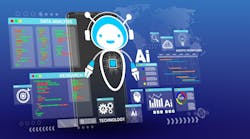AI Has a Poor Track Record, Unless You Clearly Understand What You’re Going for
The results are in for artificial intelligence – and they aren't good. The vast majority of all AI projects – 85%, according to a Gartner report – don't deliver, or simply fall short altogether. And the situation in production and manufacturing may be even worse, with an even greater failure rate. Those are awful numbers for any technology, and especially for one that is supposed to change the world.
Yet for some, AI clearly works and adds value. GE and Pepsico have used AI technologies like machine learning to improve efficiency and reduce costs. Inspired by such results, the vast majority of companies out there hope to use more AI. A PWC survey shows that 86% of U.S. executives said that AI was set to be a “mainstream technology” at their company in 2021, and that 25% of companies using AI expect to increase revenue, compared with 18% for companies overall.
In fact, companies of all kinds – including manufacturers and industrial companies – are collecting huge amounts of data, and there's no doubt that AI, if properly done, could help make production significantly cheaper, more efficient and safer. The question for companies, then, is how to reduce the risk of AI failure. And in many cases, it's not a technology issue or a lack of good data; it's a business issue.
Before investing in AI, companies need to understand what could go wrong and what they need to do to avoid failure – with the objective to reduce the failure risk to as close to zero as possible. To ensure AI success, they need to understand what AI can actually do for them.
Zero risk AI is, essentially, a zero-risk game: Companies can either understand and embrace what AI can do for them or set themselves up for disappointment by seeking out results that, given the current state of AI technology, are likely to be very difficult to achieve.
But despite AI's rather poor overall record, zero-risk AI (or close to it) is not only possible, but likely, if companies approach the issue properly. Here are some ideas on how to do that:
Know What to Expect
Among the leading reasons for AI failure in manufacturing and industrial production are inflated expectations. Companies expect a sentient computerized being that can actually think, and are disappointed when they get nothing more than an enhanced version of the data analysis that they have been doing for years. Blame IBM's Watson for that; that computer system's winning at Jeopardy significantly inflated expectations that AI could quickly solve any problem in front of it. But even though AI is a powerful tool, it really is more complex than that.
Many niche AI applications indeed do the job they were designed for quite well. But that doesn’t mean they will solve the specific problems manufacturers are seeking solutions for. When applications fail to achieve the desired goals, dissatisfied users may sour on the idea of AI altogether, denying themselves the potential benefits they could have achieved had they deployed AI technology properly.
Set Realistic Goals and Have a Plan to Achieve Them
Like any other business endeavor, companies need to base their AI goals on their resources, including the data, funds and skills they can utilize. To do that, they need to develop an AI implementation plan, not just setting an overall goal, but determining what steps are needed to achieve that goal, avoiding problems that could stem from issues such as a lack of data, limited time frames for implementation, production schedules and more.
For example, a car parts manufacturer that wants to use AI to increase manufacturing capacity needs to understand exactly which data should be analyzed, and at which parts of the production process. When looking to improve the efficiency of a machine that connects the various valves and hoses to the part’s main body, AI-based analysis should include utilizing data on characteristics of the materials, speed and pace of material processing, and the frequency of workflow stoppages due to problems on the production line, among other factors.
All of this could show how that process could be made more efficient. Similar analyses could make other procedures more efficient as well. The key is to evaluate the different steps that need to be analyzed and determine whether AI can help, before implementing an AI project.
Cloud Apps Could (Possibly) Work for You
Like in so many other areas, AI is going the cloud route – with companies like Amazon, Microsoft and others offering AI-as-a-service applications that aim to help companies in a variety of areas, using machine learning to analyze speech, text, databases and more.
Many of the apps are geared to specific areas, like fintech; for manufacturers and producers understanding what such focus means is the key to successful engagement with AI cloud-based apps. In some cases, it is true that apps built for one purpose – facial recognition for security or content-filtering, for example – could also be used for industrial purposes as well, visually examining parts for flaws before they are deployed. But the key is to review the capabilities of the app before attempting to deploy it in order to ensure that it is appropriate for the job, as well as robust enough to handle the challenge.
Marshal Resources Before You Begin
Hiring experienced engineers is a challenge; they are difficult to find (partly because so many take jobs with the big tech companies). Many companies seek to outsource AI work, but finding the right partners can be difficult, because many of the potential partners are not familiar with manufacturing processes and how to use AI tools in that space.
Manufacturers and industrial firms seeking to implement AI solutions may find their greatest success with a piecemeal approach, seeking out web apps that can help them achieve specific goals; working with partners on component projects that are part of the larger effort – and training their own people in-house.
Companies might consider providing training – whether in-house or externally – for personnel who are familiar with the production process, and who could, with some knowledge of machine learning and other AI processes, become knowledgeable enough to at least supervise the AI project. With an in-house supervisor who understands what AI can and cannot do in production, companies will find that their projects run much more smoothly and efficiently.
AI is indeed the future, and organizations know it. But without the right approach, companies are essentially wasting their time and money. Studies show that even for the 13% to 20% of AI projects that did make it into production, 78% barely made back the money spent on them. Clearly, the risk of AI failure is high; but with the right expectations, the right technology, and the right approach, those AI risks will be greatly reduced. There's even a good chance they may disappear.
Jonathan Masci is co-founder and director of Deep Learning at NNAISENSE




